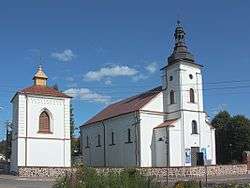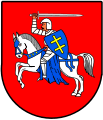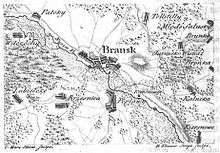Brańsk
Brańsk [braɲsk] (Belarusian: Бранск, Ukrainian: Бранськ) is an Urban Gmina (Polish: gmina miejska) (Town) in Bielsk County, Podlaskie Voivodeship. It is located north-eastern Poland.
Brańsk | |
|---|---|
 Roman Catholic church | |
 Coat of arms | |
.png) Location within Bielsk County | |
 Brańsk Location within Poland | |
| Coordinates: 52°45′N 22°50′E | |
| Country | |
| Voivodeship | Podlaskie |
| County | Bielsk |
| Gmina | Brańsk (urban gmina) |
| Town rights | 18 January 1493 |
| Government | |
| • Mayor | Czesław Sokołowski |
| Area | |
| • Total | 32.43 km2 (12.52 sq mi) |
| Population (2007) | |
| • Total | 3,822 |
| • Density | 120/km2 (310/sq mi) |
| Time zone | UTC+1 (CET) |
| • Summer (DST) | UTC+2 (CEST) |
| Postal code | 17-120 |
| Area code(s) | +48 085 |
| Car plates | BBI |
| Website | http://www.bransk.podlaskie.pl |
Geography
Location
Brańsk is located in the geographical region of Europe known as the Wysoczyzny Podlasko – Bialoruskie (English: Podlaskie and Belarus Plateau) and the mesoregion known as the Bielsk Plain (Polish: Równinę Bielską). The Nurzec River, a tributary of the Bug River, passes through Brańsk. The town covers an area of 32.43 square kilometres (12.5 sq mi).
It is located approximately:
- 140 kilometres (87.0 mi) northeast of Warsaw, the capital of Poland
- 69 kilometres (42.9 mi) southwest of Białystok, the capital of the Podlaskie Voivodeship
- 25 kilometres (15.5 mi) west of Bielsk Podlaski, the seat of Bielsk County
Climate
The region has a continental climate characterized by high temperatures during summer and long and frosty winters . The average amount of rainfall during the year exceeds 550 millimetres (21.7 in).
History
Specific historical events in Brańsk
13th century
On 23 June 1264 two armies met near Brańsk. The Battle of Brańsk lasted two days pitting the forces of Yotvingia, led by Komata (Kumata) against the well equipped Krakovian army led by the Duke of Krakow, Boleslaw V the Chaste.
15th century
On 18 January 1493, Brańsk received a city charter based on Magdeburg rights from the Grand Duke of Lithuania, Alexander Jagiellon. It was the first city in Podlachia to receive such a charter.

18th century
In 1795, as a result of the Third Partition of Poland, Brańsk was annexed to the Kingdom of Prussia and administered as a part of the Białystok Department.
19th century
In 1807, as a result of the Treaties of Tilsit, Brańsk was annexed to the Russian Empire and administered at first as a part of Belostok Oblast and from 1842 on as a part of Grodno Governorate.
20th century
On September 1, 1939, Germany attacked Poland and quickly overwhelmed it. Within days of the war's beginning, Brańsk suffered German bombardment. On September 17, 1939, the USSR attacked eastern Poland, and in partnership with Nazi Germany, partitioned Poland under the terms of the Nazi-Soviet Non-Aggression Pact of August 23. Brańsk along with all areas of Poland east of the Bug River was then occupied by the Soviet Union. All Polish and Jewish businesses of substance were confiscated by the Communist State. The Soviets remained in control of Brańsk until June 1941 when the Germans invaded their erstwhile Soviet allies. The German Army occupied the town and ordered the Jewish community to build a ghetto surrounded by barbed wire, to which the Jewish population (some 65% of the town) was confined. On November 8, 1942, the Jews of Brańsk were ordered to report to the town center, forced to march to the nearby town of Bielsk, and then transported by train to Treblinka. Within weeks, the vast majority were murdered by gassing at the Treblinka extermination camp.[1][2]
Demographics
Population
According to the 1921 census, the village was inhabited by 3.739 people, among whom 1.474 were Roman Catholic, 100 Orthodox, and 2.165 Mosaic. At the same time, 1.530 inhabitants declared Polish nationality, 32 Belarusian, 2.165 Jewish and 12 Russian. There were 493 residential buildings in the village.[3]
Detailed data as of 31 December 2007:[4]
| Total | Women | Men | ||||
|---|---|---|---|---|---|---|
| Unit | Number | % | Number | % | Number | % |
| Population | 3,822 | 100 | 1,944 | 50.9 | 1,878 | 49.1 |
| Population Density (persons/km²) | 117.9 | 56.9 | 57.9 | |||
Income
Income data from 2005:[5]
Average per capita income: 1961.03 zł
Compared to the average per capita income:
- In the Podlaskie Voivodeship: 120.40%
- In Poland: 112.20%
Municipal government
It is the seat of Gmina Brańsk, but is not part of Gmina Brańsk.
Executive branch
The chief executive of the government is the Mayor (Polish: Burmistrz).
Legislative branch
The legislative portion of the government is the Council (Polish: Rada) composed of the President (Polish: Przewodniczšcy), the Vice President (Polish: Wiceprzewodniczšcy) and thirteen councilors.
Transport
Roads and highways
Brańsk is at the intersection of a National Road and a Voivodeship Road:
- National Road

- Voivodeship Road

Streets
The major streets (Polish: Ulica) in Brańsk are:
- Rynek
- Armii Krajowej (National Road

- Bielska
- Binduga
- Boćkowska
- Błonie
- Jagiellońska
- Jana Pawła II (Voivodeship Road

- Kapicy Milewskiego
- Kasztanowa
- Klonowa
- Konopnickiej
- Kościelna
- Kościuszki (Voivodeship Road

- Mickiewicza
- Piłsudskiego
- Poniatowskiego
- Senatorska
- Sienkiewicza
- Skłodowskiej-Curie
- Szkolna
- Słowackiego
- Witosa
- Wyszyńskiego
- Ściegiennego
Public transport
Bus service
Regular bus service is provided by Państwowa Komunikacja Samochodowa (State Car Communication, PKS) via PKS Bielsk Podlaskie, PKS Białystok and PKS Siemiatycze
Rail service
The closest passenger train service is provided by Polskie Koleje Państwowe (Polish State Railways, PKP) SA from the following stations:
- Szepietowo - express and local service to Warsaw and Białystok - 28 kilometres (17.4 mi) northwest
- Bielsk Podlaski - express and local service to Siedlce and Białystok - 25 kilometres (15.5 mi) east
Economy
The land-use is as follows:[6]
- Agricultural use: 66%
- Forest land: 27%
- City: 2.34%
Major business
- Financial:Banking - Bank Spóldzielczy w Brańsku, ul. Kosciuszki 2A, 17-120 Brańsk, Poland
- Manufacturing:Plastics - Wald-Gold, ul. M. Konopnickiej 20, 17-120 Brańsk, Poland
Local attractions
Places of worship
Church of the Assumption of the Blessed Virgin Mary - Roman Catholic
- Parish serving Brańsk, Bronka, Brzeźnica, Glinnik, Jarmarkowszczyzna, Kalnica, Kiersnówek, Majerowizna, Oleksin, Otapy, Patoki, Popławy, Świrydy, Załuskie Koronne, Załuskie Kościelne[7]
- Part of the Roman Catholic Diocese of Drohiczyn
Nearby attractions
- Sanktuarium Matki Bożej Pojedniania w Hodyszewie (Our Lady of Hodyszewo Sanctuary) in Hodyzewo - 12 kilometres (7.5 mi) northwest
- Ossoliński Palace in Rudka - 7 kilometres (4.3 mi) west
Notable people
- Jan Klemens Branicki – Polish nobleman
- Cezary Kosiński – Polish actor
- Ignatius Kapitsa-Milewski – archivist and author
- Shimon Shkop – Jewish scholar and rabbi (1906–1920)
- Moshe Rosen (Nezer HaKodesh) - Jewish scholar and rabbi (1870–1957)
- Zofia Drzewiecka – Recipient of the Righteous among the Nations Medal
- Waclawa and Pawel Sobolewski – posthumous recipients of the Righteous among the Nations Medal
- Antoni Sobolewski – posthumous recipient of the Righteous among the Nations Medal
- Aleksander Sobolewski – posthumous recipient of the Righteous among the Nations Medal
Miscellanea
- The Righteous among the Nations Medal has been granted to 14 current and former residents of Brańsk by Yad Vashem[9]
External links
References
- Eva Hoffman. Shtetl: The Life and Death of a Small Town and the World of Polish Jews. Houghton Mifflin, 1997.
- Zbigniew Romaniuk. The Story of Two Shtetls: Brańsk and Ejszyszki, Part One. The Polish Educational Foundation in North America, 1998.
- Skorowidz miejscowości Rzeczypospolitej Polskiej: opracowany na podstawie wyników pierwszego powszechnego spisu ludności z dn. 30 września 1921 r. i innych źródeł urzędowych., t. T. 5, województwo białostockie, 1924, s. 14.
- "Central Statistical Office (GUS) Population: Size and Structure by Administrative Division" (in Polish). 2007-12-31. Archived from the original on 2008-05-05.
- "Edytor Serwis Sp. z o.o. REGIOset Portal" (in Polish). 2005-12-31.
- "Strona Urzędu Miasta Brańsk - Brańsk Government Website" (in Polish). 2008-06-25.
- "Parafia Wniebowzięcia Nmp w Brańsku" (in Polish). 2008-08-16.
- "Dekanat Bielsk Podlaski" (in Polish). 2008-08-16. Archived from the original on 2002-10-28.
- "Another Pole added to Righteous among the Nations - Polskie Radio". 2008-06-23.
_COA.svg.png)
